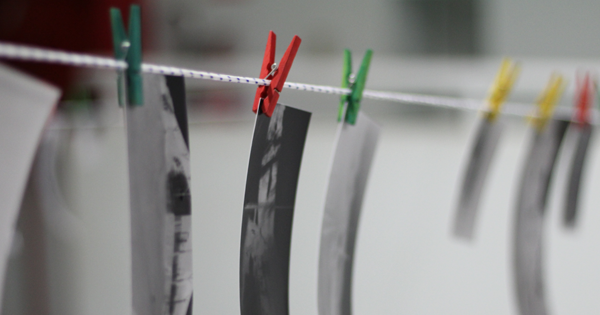
Dealing with mould after a flood — checklist
Mould can quickly appear on whānau collections after a flood. This factsheet will help you understand mould, take action if you find mould on water-damaged whānau collection including steps to clean damaged items safely.
Mould infestations after a flood
After a flood, mould infestations can quickly start to appear on our whānau collections. The collections do not need to have been water-logged and may not have even been directly affected by water for mould to develop.
This is because mould is always present, lying dormant (inactive) until the right conditions trigger its growth. Mould growth can occur within 48 hours.
Signs you might have mould
Mould is a type of fungi activated by a significant change in temperature and moisture. To grow and thrive it needs a source of food and moisture. Signs you have mould include:
a musty odour could indicate mould is present
visible growth – look for fuzzy, hairy or powdery patches of mould on the surface of your whānau collections
allergic reactions like sneezing, coughing, skin irritations when handling your whānau collections might indicate you have been exposed to mould.
Health and safety first
Mould can pose a health risk to individuals who work with these collections. Mould spores settle on all surfaces and are carried in the air. To protect yourself:
wear protective clothing such as PPE, or overalls
wear long sleeves and pants to cover your skin and avoid direct contact
don't use your protective clothing for any other purpose
use nitrile gloves and P2 masks that filter out mould spores
work in a ventilated area
Assess your whānau collection for mould
Examine your items for visible signs of mould. Start with the collections directly affected by water and work systematically through your collection.
Separate collections that show visible signs of mould or have a musty odour.
Place the affected items into sealable plastic bags or containers to prevent mould spores from spreading
If possible, move items to a space that is well-ventilated and dry.
Develop a cleaning plan to deal with the mould
Cleaning mould will reduce the risk of future outbreaks, and the risk of the mould spreading and make items safer to handle. Cleaning:
removes the mould spores
reduces the risk of mould regrowth
reduces risk of mould spreading to other whānau items
removes a health hazard.
Mould must be inactive or dormant before any cleaning can be done
Active vs inactive mould
Active mould appears wet or ‘smudges’ when touched.
Inactive mould is dry and powdery.
Inactive mould is dormant until the right conditions trigger its growth again.
Identify your space
Work outside if possible, or work in a well-ventilated area.
If you work indoors, work in front of a window with a fan that draws air outside. Close off the room from other areas of the house.
Tools and materials to clean inactive mould
Table covered in clean newsprint paper.
HEPA-filtered vacuum cleaner with a bag.
Soft brushes
Rubbish bags
A cleaning spray for cleaning down surfaces not for us on the collection.
Tools that are nice to have are:
oscillating fan
universal micro tool kit with a hose attachment to clean bound volumes. Something like this clean up car accessory kit
Air-drying to deactivate mould
Mould must be deactivated before further work can be carried out on your whānau items. Air-drying items helps dry out damp items and deactivate the mould spores. To air-dry items:
separate individual pages of documents to facilitate airflow during air-drying
if hard-covered book bindings are undamaged they can be stood upright with their pages fanned open
use fans pointed toward an open window to promote air circulation and push mould spores out the window
place the fan at a safe distance to prevent fluttering of pages, which can lead to damage.
Find out more about air-drying with our checklist Drying your whānau collections — checklist.
Cleaning process for inactive mould
Use a soft-haired brush to remove visible mould brushing away from you.
Brush away from you toward a HEPA-filter vacuum cleaner.
A HEPA filter captures the mould spores that a regular filtered vacuum cleaner does not. Use a vacuum cleaner with a bag so the bag (and spores) can be removed at the end of a cleaning session.
If a HEPA-filter vacuum is not available, work outside to prevent recontamination of the space.
Avoid direct contact with items when you are vacuuming. The suction might damage weakened materials.
Hover over the item when you are vacuuming and use a soft brush to brush inactive mould ‘into’ the nozzle.
Wrap work in clean paper or put it in a box at the end of each cleaning session to avoid contamination — do this until completed and then rehouse permanently in new tissue/box.
Clean storage areas. A commercially available cleaning spray solution will work.
Freezing
It is possible to freeze collection items. Freezing does not kill mould but does stop it growing. Freezing effectively prevents further damage until you have the time, space, tools and materials to air-dry and clean your whānau items.
More about freezing water-damaged whānau collections
What next?
Store items off floors and away from outside walls, especially cold, south-facing walls.
Make sure there is good circulation of air around your items.
Regularly monitor and check the areas of mould damage on your whānau items.
Look for signs of mould on and in the pages of the pukapuka and in the surrounding storage area.
Be aware that spring and autumn are the key times for mould growth.
Need help or advice?
Get in touch if you need advice or help about preventing or managing mould. The National Preservation Office at the National Library provides professional advice and assistance in caring for heritage items.
Email — preservation@dia.govt.nz
National Preservation Office Te Tari Tohu Taonga
PO Box 12349
Wellington 6144
Related content

Drying your whānau collections — checklist
A short checklist to help you safely dry water-damaged belongings such as photographs, books, artworks and music collections after a flood.
Collection salvage guidelines
Guidelines. including do's and don'ts. to help you dry water-damaged belongings organised by format, for example, works of art on paper, manuscripts, newspapers, sound recordings, oversize items and photographs.Feature image at top of page: Mould close-up, Microscopic Aspergillus fungi 3d illustration. Shutterstock